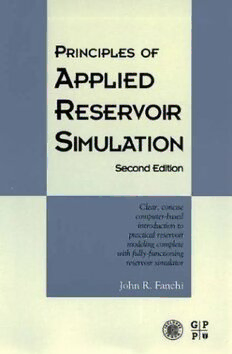
Principles of Applied Reservoir Simulation PDF
Preview Principles of Applied Reservoir Simulation
Principles of Applied Reservoir Simulation This page intentionally left blank Principles of Applied Reservoir Simulation Second Edition _£ Gulf Professional Publishing ii an imprint of Butterworth-Heinemann Amsterdam Boston Heidelberg London New York Oxford Paris San Diego San Francisco Singapore Sydney Tokyo Gulf Professional Publishing is an imprint of Elsevier. Copyright €> 2001 by Elsevier (USA). All rights reserved. Originally published by Gulf Publishing Company, Houston, TX. No part of this publication may be reproduced, stored in a retrieval system, or transmitted in any form or by any means, electronic, mechanical, photocopying, recording, or otherwise, without the prior written permission of the publisher. Permissions may be sought directly from Elsevier's Science & Technology Rights Department in Oxford, UK: phone: (+44) 1865 843830, fax: (+44) 1865 853333, e-mail: [email protected]. You may also complete your request on-line via the Elsevier Science homepage (http://www.elsevier.com), by selecting 'Customer Support' and then 'Obtaining Permissions'. /~"^% ^* This book is printed on acid-free paper. Library of Congress Cataloging-in-Publication Date Fanchi, John R. Principles of applied reservoir simulation/John Fanchi. - 2nd edition p. cm. Includes bibliographical references and index. ISBN 0-88415-372-X(alk. paper) 1. Oil fields-Computer simulation. 2. Petroleum-Geology-Mathematical models. I. Title TN870.53.F36 2000 622'.3382'0113-dc21 00-064650 British Library Cataloguing-in-Pulication Data A catalogue record for this book is available from the British Library. The publisher offers special discounts on bulk orders of this book. For information, please contact: Manager of Special Sales Elsevier Science 200 Wheeler Road Burlington, MA 01803 Tel: 781-313-4700 Fax: 781-313-4802 For information on all Gulf publications available, contact our World Wide Web homepage at http://www.bh.com/gulf 10 9 8 7 6 5 4 3 2 Printed in the United States of America. Disclaimer: Some images in the original version of this book are not available for inclusion in the eBook. To my parents, John A. and Shirley M. Fanchi This page intentionally left blank CONTENTS About the Author xiv Preface to Second Edition xv Preface to First Edition xvi 1 Introduction to Reservoir Management 1 .,1 Consensus Modeling 2 1.2 Management of Simulation Studies 4 1.3 Outline of the Text 6 Exercises 7 Part I - Reservoir Engineering Primer 2 Basic Reservoir Analysis 11 2.1 Volumetrics 11 2.2 Material Balance 12 2.3 Decline Curve Analysis 16 Exercises 17 3 Multiphase Flow Concepts 19 3.1 Basic Concepts 19 3.2 Capillary Pressure 22 3.3 Mobility 24 3.4 Fractional Flow 26 Exercises 30 VII 4 Derivation of the Flow Equations 31 4.1 Conservation of Mass 31 4.2 Flow Equations for Three-Phase Flow 33 4.3 Flow Equations in Vector Notation 36 Exercises 37 5 Fluid Displacement 39 5.1 Buckley-Leverett Theory 39 5.2 Welge's Method 42 5.3 Miscible Displacement 44 Exercises 46 6 Frontal Stability 48 6.1 Frontal Advance Neglecting Gravity 48 6.2 Frontal Advance Including Gravity 51 6.3 Linear Stability Analysis 53 Exercises 55 7 Pattern Floods 56 7.1 Recovery Efficiency 56 7.2 Patterns and Spacing 58 7.3 Pattern Recovery 61 Exercises 63 8 Recovery of Subsurface Resources 64 8.1 Production Stages 64 8.2 Enhanced Oil Recovery 69 8.3 Nonconventional Fossil Fuels 71 Exercises 73 9 Economics and the Environment 75 9.1 SPE/WPC Reserves 75 9.2 Basic Economic Concepts 77 9.3 Investment Decision Analysis 81 9.4 Environmental Impact 82 Exercises 85 vin Part II - Reservoir Simulation 10 Overview of the Modeling Process 89 10.1 Basics Reservoir Analysis 89 10.2 Prerequisites 90 10.3 Computer Modeling 90 10.4 Major Elements of a Reservoir Simulation Study 92 Exercises 94 11 Conceptual Reservoir Scales 95 11.1 Reservoir Sampling and Scales 95 11.2 Integrating Scales - the Flow Unit 97 1 i .3 Geostatistical Case Study 101 Exercises 104 12 Reservoir Structure 106 12.1 Giga Scale 106 12.2 Mega Scale 111 12.3 Reservoir Description Using Seismic Data 115 Exercises 119 13 Fluid Properties 120 13.1 Fluid Types 120 13.2 Fluid Modeling 124 13.3 Fluid Sampling 128 Exercises 128 14 Rock-Fluid Interaction 131 14.1 Porosity, Permeability, Saturation and Darcy'sLaw 131 14.2 Relative Permeability and Capillary Pressure 135 14.3 Viscous Fingering 139 Exercises 141
